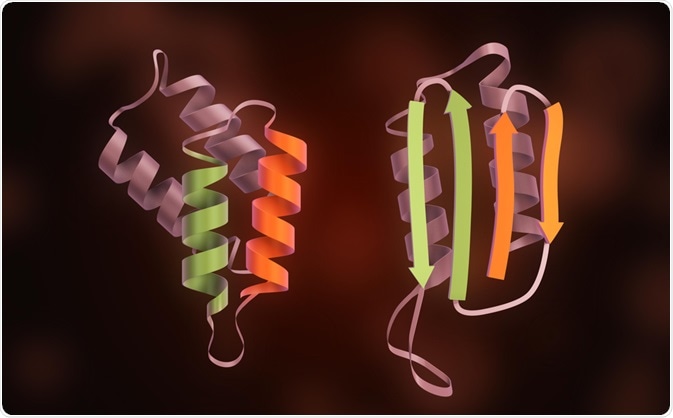A prion is a type of protein that can trigger the normal protein present in the brain to fold abnormally. These multichain clusters of the abnormally folded cellular prion protein cause neurodegenerative diseases in both humans and animals.

Prion. Image Credit: Oscar Collica/Shutterstock.com
What is the General Mode of Action of Prion Disease?
Prions are different from pathogenic microbes (virus, bacteria, etc.) because they are composed of proteins and lack genetic materials. When a prion enters the body of healthy individuals, it converts normal (correctly folded) protein into the disease-associated form (rogue protein).
The function of a normal form of protein present in the brain is unclear. However, researchers believe that these proteins may play a critical role in synaptic transmission, i.e., transport of messages between brain cells.
Once a disease-associated form of protein is established, it soon starts converting more normal protein to abnormal folding, similar to a chain reaction. This leads to a progressive accumulation of rogue protein in the brain (or some other organs) and, thereby, hampers its normal function. Scientists have also reported the presence of a clinical incubation phase during which replication of abnormally folded proteins takes place.
Types and Characteristics of Prion Diseases
Genetic Prion Disease
Genetic prion diseases have been categorized into three groups, based on their clinicopathologic features. These are Gerstmann-Sträussler-Scheinker syndrome, Creutzfeldt-Jakob disease, and fatal familial insomnia. Genetic prion disease occurs due to different types of mutations of the human prion protein gene (PRNP). For example, mutations caused by missense mutations, several octapeptide repeat insertion (OPRI) mutations, stop codon mutations, etc.
Diagnosis of genetic prion disease is very difficult. This is because of immense diversity in symptoms or patterns, for example, variability in the range of age of onset, i.e., from children to the very elderly, varied neuropathologic features, etc.
Sporadic Prion Disease
This kind of prion disease usually affects people between the ages of 45-75. The symptoms of the disease may vary immensely. Early symptoms may include mood swings, headaches, sleep disturbance, dizziness, and loss of appetite and weight. The onset of the disease is followed by a rapid decline in health.
A common feature of sporadic prion disease is rapidly progressive dementia affecting many aspects of brain functioning. An example of sporadic prion disease is Creutzfeldt-Jakob disease. This disease leads to patients having a mean survival duration of about 6 months, with approximately 90% of patients dying within 1 year.
Acquired Prion Disease
This form of human prion disease is rare. An example of acquired prion disease is Kuru, which was identified among the Fore people of Papua New Guinea. This disease has largely been eradicated by the abolition of the practice of endocannibalism. However, the rare emergence is due to the longer incubation periods, i.e., longer than 50 years.
Recent research on the Fore population that survived the kuru epidemic reported PRNP polymorphism at codon 127. In mice models, such polymorphism has imparted protection against prion disease. Researchers said that understanding the mechanism of the effect of this polymorphism may help develop treatments for prion diseases in the future.

Prion Disease. Image Credit: ibreakstock/Shutterstock.com
Are Prions Neurotoxic?
Previously, researchers assumed that prions were neurotoxic by themselves. Recent developments in research techniques involve not only the isolation of exceptionally pure prions from mice brain but also the maintenance of their characteristic features. This has immensely improved the researchers’ understanding of prions who found that these isolated prions are paired, rod-like double-helical fibers. They have tried to correlate such structural features with infectivity.
Researchers have further reported that even though the brain homogenates from symptomatic prion-infected mice are highly toxic to cultured neurons, exceptionally pure infectious prions are not directly neurotoxic. They have also found that the use of sodium lauroylsarcosine for the treatment of brain homogenates from prion-infected mice has eliminated the toxicity without diminishing infectivity. This result also suggests that prions are not directly neurotoxic.
Examples of Prion Diseases
As stated earlier, prion diseases are found in both humans as well as animals. Some of the examples are enlisted below.
Human Prion Diseases
Creutzfeldt-Jakob Disease (CJD): This is a type of sporadic prion disease, which is commonly known as classical CJD or sporadic CJD. Sporadic CJD is one of the most prevailing prion diseases that is found across the globe. It has been reported that approximately one person in every million develops sporadic CJD per year.
The actual mechanism behind the onset of this disease is not known. It may suddenly develop due to a series of chemical chain reactions in the body or cellular mutations.
Fatal Familial Insomnia: This is an extremely rare form of genetic prion disease that occurs due to a single PRNP point mutation, D178N with the cis codon 129M. Typically, this disease is found in people in their late forties, and patients suffer from severe progressive insomnia over several months, followed by dysautonomia (e.g., hyperhidrosis, tachycardia, and hyperpyrexia). The average surviving time is about 18 months.
Some other examples of human prion diseases are Kuru, Variant Creutzfeldt-Jakob Disease and Gerstmann-Straussler-Scheinker Syndrome.
Animal Prion Diseases
Bovine Spongiform Encephalopathy (BSE): This type of prion disease causes progressive neurological disorder in cattle. The exact mechanism of the transmissible agent (prions) is not well understood.
Chronic Wasting Disease (CWD): This type of prion disease affects elk, deer, reindeer, and moose. Typically, the symptoms may develop within a year of infection. The animals with CWD undergo drastic weight loss, listlessness, and show other neurologic symptoms. To date, there are no treatments or vaccines for CWD.
Some other examples of animal prion diseases are Scrapie, Transmissible Mink Encephalopathy, Feline Spongiform Encephalopathy, and Ungulate Spongiform Encephalopathy.
References and Further Reading:
- Du, Z., Regan, J., Bartom, E. et al. (2020). Elucidating the regulatory mechanism of Swi1 prion in global transcription and stress responses. Science Report. 10, 21838. https://doi.org/10.1038/s41598-020-77993-0
- Prion and prion disease. University College London.
- Prion Diseases. Centers for Disease Control and Prevention.
- Geschwind M. D. (2015). Prion Diseases. Continuum (Minneapolis, Minn.), 21(6 Neuroinfectious Disease), 1612–1638. https://doi.org/10.1212/CON.0000000000000251
- Benilova, I., et al. (2020). Highly infectious prions are not directly neurotoxic. National Academy of Sciences. Proceedings of the National Academy of Sciences.117, 38. 23815-23822. DOI: 10.1073/pnas.2007406117
Further Reading